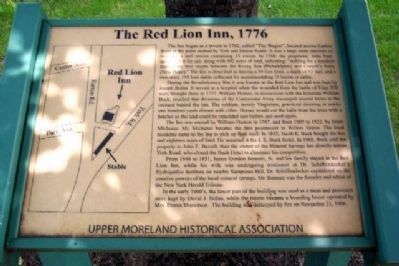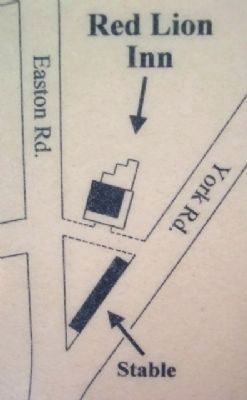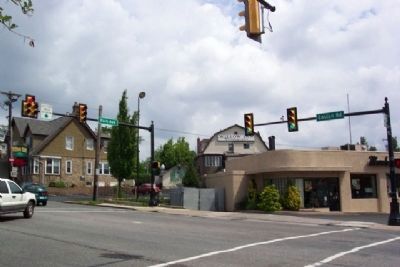According to historian Edward Momoralla, Willow Grove began as part of a land grant from King Charles II to William Penn in 1681. A 9.8-acre tract was sold by Penn to physician Nicholas More, which is how the land became known as the Manor of Moreland, and later, Moreland Township.
For an extensive history of the town’s origins, you can read “A Brief History of Willow Grove” here.
The Square and Compass Tavern
The former Square and Compass Tavern was once located at the corner of Old York Road and Eckard Avenue. The British referred to it as the Mason’s Arms, a reference to a sign hanging outside.
During the American Revolution, Square and Compass was utilized as an outpost for American Continental forces stationed in Abington.
On the property across the street (adjacent to the Wells Fargo) was a hotel. According to legend, an American officer stationed at Abington during the Revolutionary War came out of the hotel to find that his horse had been stolen. He was later wounded in an altercation with British soldiers while making his way back to the American army without his horse.
In 1787, the Tavern was purchased by Mary Moore, whose husband was a Revolutionary War veteran, Colonel John Moore. The establishment was sometimes used for voting and political rallies. Some called Abington “Moorestown” as a tribute to Colonel Moore.
In 1887, the Tavern was purchased by Abington Presbyterian Pastor Reverend Leighton W. Eckard, who had little tolerance for drink and subsequently razed the building.
He paid a little over $8,000 for the Tavern in 1787 and demolished it in 1790.
The Red Lion Inn of Willow Grove
The Red Lion Inn of Willow Grove, a 2.5-story stone structure with 23 rooms, dates back to 1762. It was originally a tavern called “The Wagon” until the Revolutionary War when it also served as a hospital for The Battle of Edge Hill’s wounded soldiers.
In 1778, British forces under Lt. Colonel Abercromby and Major Simcoe marched right past the Red Lion Inn on their way to modern-day Horsham and a battle with the Americans near the Crooked Billet Inn.

According to the Historical Marker Database, the inn was located at the intersection of York and Easton Roads and had a large stable that could accommodate as many as 75 horses or cattle. It was owned by William Heaton in 1787, and from 1809 to 1822, by Israel Michener, who was Willow Grove’s first postmaster.

It was renamed the J. E. Buck Hotel in 1842 until it was purchased and subsequently closed in 1868 by a local hotel owner.
The lower part of the building was used as a meat and provision store in the early 1900s and the inn’s rooms served as a boarding house until the building was destroyed by fire on November 21, 1906.

Former location of the Red Lion Inn.
For all the latest news, follow us on Facebook or sign up for Glenside Local’s “Daily Buzz” newsletter here.
Photos courtesy Uppermorelandtownship.org and William Fischer, Jr. of Scranton, Pennsylvania. Sources for Square and Compass: “A Tour of Old Abington” by Helen L. Shaffer, the Old York Road Historical Society’s Book on Images of America for Abington, Jenkintown, and Rockledge published in 2000

